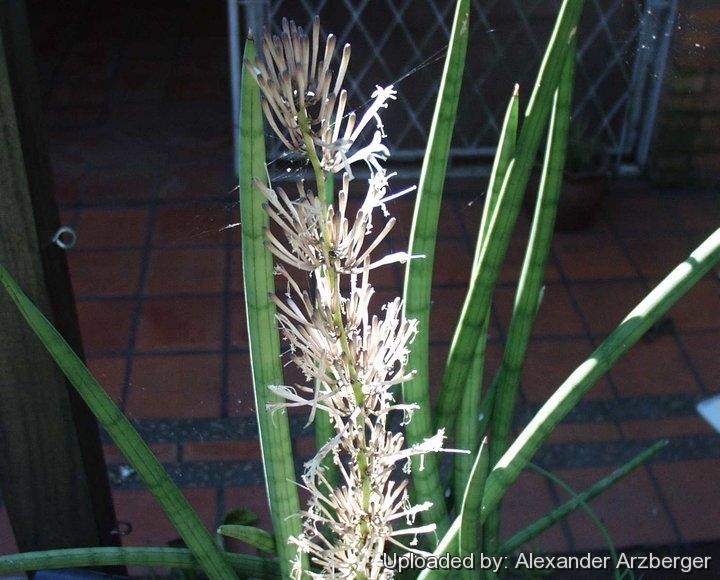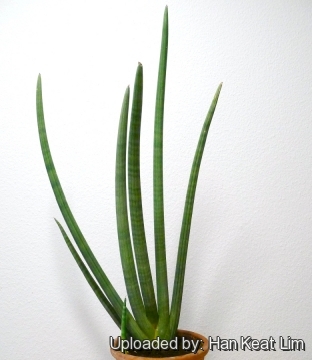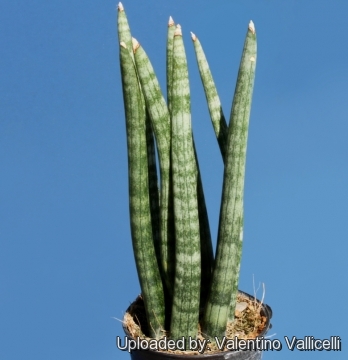
Sansevieria cylindrica Photo by: Alexander Arzberger
Origin and Habitat: South Tropical Africa and Natal
Synonyms:
See all synonyms of Sansevieria cylindrica
back
Accepted name in llifle Database:Sansevieria cylindrica BojerHortus Maurit. 349; Hook. Bot. Mag. t. 5093.Synonymy: 7
back
Common Names include:
ENGLISH: Elepbant's Toothpick, African Spear, Cylindrical Snake Plant, Bow String Hemp, Snake Plant, Spear Sansevieria
CHINESE (中文): 石筆虎尾兰
Description: Sansevieria cylindricaSN|15713]]SN|15713]] is a most distinct and curious-looking stemless succulent plant that grows fan-shaped, with stiff leaves growing from a basal rosette. It forms in time a colony of solid cylindrical leaves. It is slow growing. The species is interesting in having rounded instead of strap-shaped leaves. It spreads by rhizomes - roots that travel under the soil surface and develop offshoots some distance from the original plant.
Rosette: it forms a few leaved distichous rosettes with 3-4 leaves (or more) from underground rhizomes.
Leaves: Round, leathery, rigid, erect to arching, channeled only at the base, dark-green with thin dark green vertical stripes and horizontal grey-green bands about (0.4)1-1,5(-2) m in height and about 2-2,5(-4) cm thick.
Fowers: The 2,5-4 cm flowers are tubular, delicate greenish-white tinged with pink and lightly fragrant.
Blooming season: It blooms once a year in Winter to Spring (or summer too). It tends to bloom more readily from a young age than other varieties.
Notes: The genus Sansevieria numbers about 60 species most of them native of Africa, it has been variously included in the Amaryllidaceae, the Liliaceae and the Agavaceae but is nowadays usually placed in the Dracaenaceae.
Bibliography: Major references and further lectures
1) Erhardt, W. et al. 2008. "Der große Zander: Enzyklopädie der Pflanzennamen."
2) Liberty Hyde Bailey Hortorium. 1976. Hortus third.(Hortus 3)
3) Merxmüller, H., ed. 1966–1972. "Prodromus einer flora von Sudwestafrika. "
4) Oliver, D. et al., eds. v. 1-3, & W. T. Thiselton Dyer et al., eds. v. 4-10. 1868–1937. "Flora of tropical Africa."
5) St. John, H. 1973. "List and summary of the flowering plants in the Hawaiian islands."
6) Walker, E. 1976. "Flora of Okinawa and the southern Ryukyu Islands."
7) Brink, M. & Achigan-Dako, E.G. “Fibres” PROTA, 2012
 Sansevieria cylindrica Photo by: Han Keat Lim
Sansevieria cylindrica Photo by: Han Keat Lim Sansevieria cylindrica Photo by: Valentino Vallicelli
Sansevieria cylindrica Photo by: Valentino Vallicelli Sansevieria cylindrica Photo by: Valentino Vallicelli
Sansevieria cylindrica Photo by: Valentino Vallicelli Sansevieria cylindrica Photo by: Valentino Vallicelli
Sansevieria cylindrica Photo by: Valentino VallicelliCultivation and Propagation: Sansevieria cylindricaSN|15709]]SN|15713]] are easy to grow and tolerate a wide range of conditions. Use a soil mix consisting of 3 parts loam to 1 part of pumice. The plants are very drought tolerant and are watered about every other week during the growing season. They are fertilized once during the growing season with a balanced fertilizer. During the winter months they are watered once a month.
Outdoors: In the garden In mild to tropical climates it prefers semishade or shade and it is not fussy.
Propagation: Sansevieria cylindricaSN|15713]]SN|15713]] are propagated by cuttings or by divisions taken at any time. Cuttings should be at least 7 cm long and inserted in moist sand. A rhizome will emerge at the cut edge of the leaf.
Use: It makes a choice designer's architectural statement forming a colony of vertical dark green spires. It is popular as an ornamental plant as it is easy to culture and take care of in a home.
Traditional uses: Sansevieria angolensisSN|15713]]SN|15709]] leaves contain fibre (“Musokelazebe" or "Sakachebi" Fibre) used for making deep sea dredging ropes.














